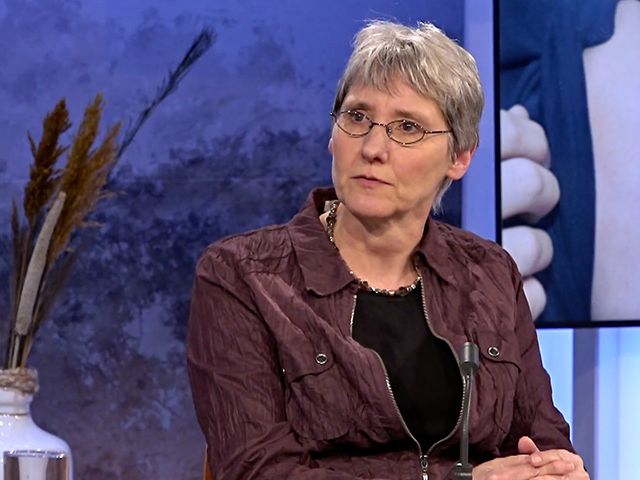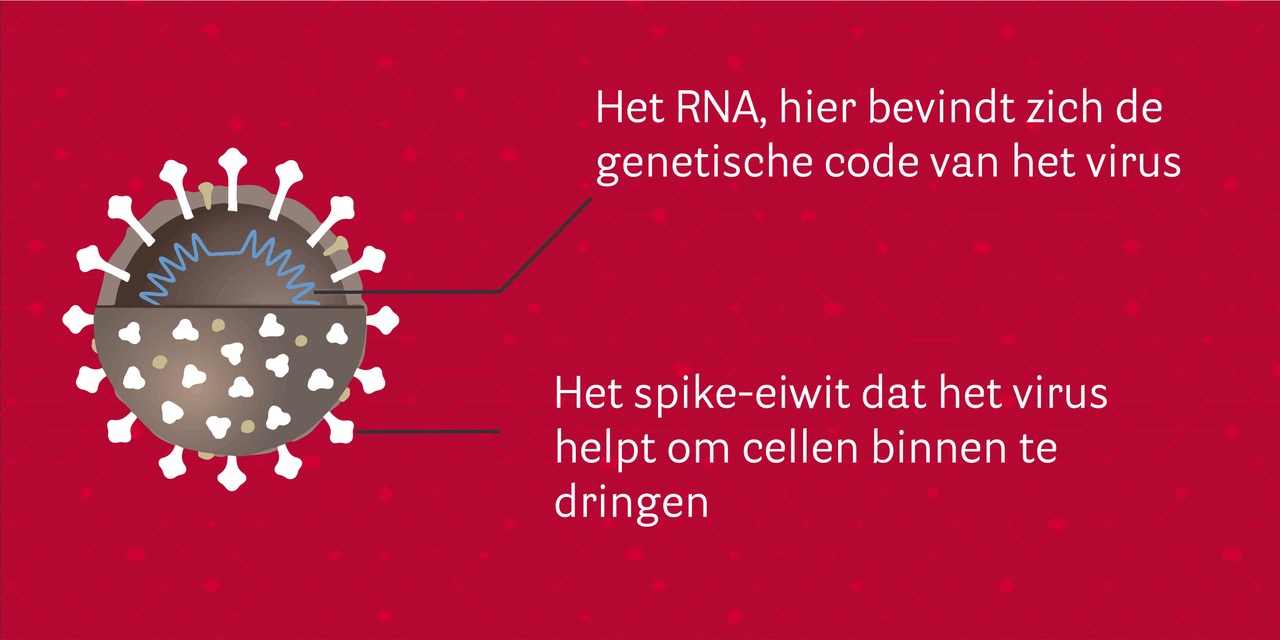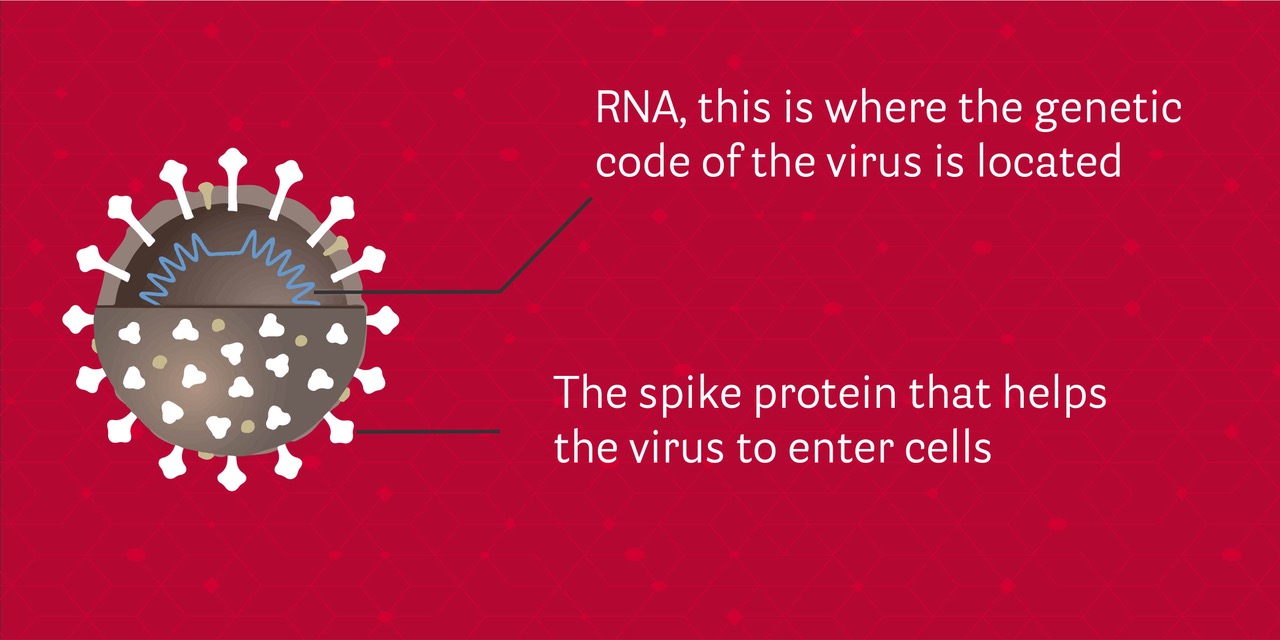Van angst voor het virus naar angst voor de vaccinatie: de betrouwbaarheid van het COVID-19 vaccin

English translation below
Anke Huckriede, hoogleraar Vaccinologie aan de RUG en werkzaam voor het UMCG, is dé vaccinexpert van het Noorden. Vaccinaties blijken een gevoelig onderwerp uit de discussies die erover gevoerd worden. Nu het coronavaccin dichterbij komt heeft bijna iedereen een mening erover. Hoe werken de coronavaccinaties? Is het terecht dat mensen argwanend zijn over het vaccin en wanneer bereiken we groepsimmuniteit? In gesprek met Anke Huckriede over het coronavaccin.
Volgens de vaccinoloog is het coronavaccin belangrijk om drie redenen: “Ten eerste om jezelf te beschermen tegen nare gevolgen van een infectie, ten tweede om minder of niet besmettelijk te zijn voor anderen en ten derde om mee te helpen het virus zo snel mogelijk in te dammen om van de inperkende maatregelen af te komen en weer terug te kunnen gaan naar een normaal leven.”
Twee soorten vaccins
Volgens Huckriede zijn er grofweg 2 soorten vaccins: “Er zijn vaccins die het spike-eiwit van het SARS coronavirus 2 bevatten, dit is een eiwit op het oppervlak van de virusdeeltjes. Daarnaast heb je vaccins die niet het spike-eiwit zelf bevatten maar de instructie, de genetische code, om dit te maken. De vaccins die we kennen voor andere infectieziekten vallen allemaal in de eerste categorie. De vaccins die het verst in ontwikkeling zijn voor COVID-19 vallen in de tweede categorie.”
We kunnen ons straks dus laten inenten met het vaccin dat de genetische code bevat om het spike-eiwit te maken. Hoe werkt zo’n vaccin precies? “De instructies voor het maken van het spike-eiwit, bijvoorbeeld in vorm van RNA, wordt ingespoten en moet vervolgens door cellen van ons lichaam worden opgenomen. Die cellen beginnen dan het spike-eiwit te produceren en scheiden het uit of tonen het op hun oppervlak. Vervolgens kan het immuunsysteem op het vreemde eiwit reageren net als op een ingespoten eiwit.”

Veel mensen zijn bezorgd als ze horen dat er vreemde RNA in hun lichaam wordt gespoten en in hun cellen beland. Dit is echter iets wat ook bij virusinfecties gebeurt, legt Huckriede uit, “Het is dus helemaal niets bijzonders, elk van ons maakt dit meerdere keren per jaar mee. Bij elke virusinfectie moet het virus zijn erfelijk materiaal in een gastheercel brengen. Die gastheercel wordt dan aangezet tot productie van de viruseiwitten en andere bestanddelen die dan weer tot nieuwe viruspartikels worden samengevoegd die worden uitgescheiden. Een heel natuurlijk proces dus.”
Argwaan vanwege de snelle ontwikkeling
De ontwikkeling van vaccins tegen COVID-19 is met ongekende snelheid verlopen. Er zijn inmiddels drie vaccins die hun werkzaamheid in grote klinische studies met tienduizenden deelnemers hebben bewezen. “Twee vaccins, beiden van het type RNA vaccin, lieten daarbij een hele hoge effectiviteit van rond de 95% zien.” legt Huckriede uit. Ondanks dat de testresultaten veelbelovend zijn, is de bereidheid van Nederlanders om zich te laten vaccineren tegen corona de afgelopen maanden gedaald. Is het terecht dat er zo’n grote groep mensen argwanend is tegenover het vaccin? “De ontwikkeling is inderdaad heel snel gegaan. Dit heeft vooral twee oorzaken,” legt Huckriede uit. “Ten eerste hoefde men niet bij nul te beginnen. In de 21ste eeuw kregen we reeds tweemaal te maken met nieuwe coronavirussen, het eerste SARS virus in 2003 en het MERS virus in 2012. Beide virussen hebben niet tot pandemieën geleid maar men heeft wel kandidaat vaccins ertegen ontwikkeld. Daarbij is men veel te weten gekomen over coronavirussen en is er technologie ontwikkeld waardoor men nu heel snel vaccins tegen het SARS-CoV-2 virus kon maken.
“Ten tweede worden nu de verschillende fases van vaccinontwikkeling die normaliter achter elkaar plaatsvinden parallel uitgevoerd. Toen men de eerste vaccinprototypes klaar had is men dus tegelijk met dierproeven ook al begonnen de vaccins in kleine groepen mensen te testen, in zogenoemde fase-1 studies. Toen daaruit bleek dat de vaccins geen nare bijwerkingen veroorzaakten heeft men de groepen uitgebreid en werd er in fase-2 studies op grotere schaal gekeken naar de veiligheid en werd de dosis bepaald die voor nodig is voor de inductie van voldoende antistoffen. Terwijl deze studies liepen heeft men reeds alle voorbereidende werkzaamheden voor de volgende fase, de fase-3 studies, uitgevoerd. Zodra men uit de fase-2 studies wist welk vaccin de beste immuunresponsen opwekt en bij welke dosis, konden de fase -3 studies beginnen waarbij men in tienduizenden deelnemers kijkt naar de werkzaamheid van de vaccins. Deze studies zijn zo opgezet dat men wacht totdat een van tevoren vastgelegd aantal SARS-CoV-2 infecties is opgetreden in de gehele studiepopulatie en vervolgens kijkt hoe die verdelen over de ingeënte en de placebogroep. Omdat er – helaas- veel COVID-19 infecties voorkwamen waren de nodige aantallen infecties vrij snel bereikt, sneller dan men had verwacht. Parallel aan het uitvoeren van de klinische studies zijn de autoriteiten begonnen met het bestuderen van de data over productie, veiligheid, dierproeven et cetera, iets wat normaliter pas gebeurd als de fase-3 trial is afgesloten. Hierdoor kon grote tijdswinst geboekt worden. Ook is men direct al begonnen met opschaling van de productieprocessen en heeft men al miljoenen doses vaccins geproduceerd met het risico dat ze misschien nooit gebruikt zouden worden.”
Er zijn volgens Huckriede dus geen bochten afgesneden, alle voorgeschreven stappen van vaccinontwikkeling zijn keurig doorlopen. “Maar waar een vaccinfabrikant normaliter deze stappen achter elkaar neemt om geen onnodige investeringen te doen was het nu mogelijk om de stappen parallel uit te voeren door de enorme hoeveelheden geld die in de ontwikkeling van een COVID-19 vaccin zijn gepompt,” legt Huckriede uit.
Groepsimmuniteit
Volgens Huckriede kunnen we groepsimmuniteit bereiken voor het SARS-CoV-2 als circa 70% van de bevolking gevaccineerd is. “Gezien de mate van besmettelijkheid van het virus en de effectiviteit van de vaccins zou dat voldoende moeten zijn om verdere verspreiding van het virus in de bevolking te voorkomen,” legt Huckriede uit. “De kans dat een geïnfecteerd iemand een bevattelijk iemand tegenkomt en die op zijn beurt ook weer het virus door kan geven en zo voorts zou dan namelijk heel klein zijn en het virus zou zich niet kunnen handhaven in zo’n ingeënte populatie. Zo kunnen ook mensen die niet zelf gevaccineerd kunnen worden of een slecht immuunsysteem hebben, denk aan ouderen of mensen die chemotherapie krijgen, beschermd worden. Hoe minder mensen zich laten inenten hoe langer het zal duren totdat de aantallen van nieuwe infecties gedaald zijn tot een acceptabel niveau en hoe langer de beperkende maatregelen zullen moeten worden gehandhaafd.”
Einde virus in zicht?
Zullen we het virus verslaan of zullen we er in de toekomst altijd mee te maken hebben? “De toekomst zal het leren,” zegt Huckriede. “Ik denk wel dat het gaat lukken om het virus dusdanig in te perken dat het geen onmiddellijk gevaar voor de volksgezondheid meer is en ons gezondheidssysteem niet meer dreigt te laten bezwijken. Wellicht zullen we om de paar jaar een opfrisvaccinatie moeten halen net zoals dat ook voor andere infectieziekten het geval is. Zonder vaccin vrees ik dat het nog jaren zou gaan duren voordat we het virus enigszins onder controle hebben en zullen we nog lang te maken hebben met inperkende maatregelen.”
From fear of the virus to fear of the vaccine: the safety of the COVID-19 vaccine
Anke Huckriede, Professor of Vaccinology at the University of Groningen and working at the UMCG, is the vaccine expert of the North. Vaccinations appear to be a sensitive topic with often heated discussions about them. Now that the corona vaccine is right around the corner, almost everyone has an opinion about it. How does the corona vaccine work? Is it legitimate that people do not trust the vaccine and when will we achieve herd immunity? In conversation with Anke Huckriede about the corona vaccine.
According to the vaccinologist, the corona vaccine is important for three reasons: "Firstly, to protect yourself from the awful consequences of the infection; secondly, to be less or not infectious to others; and thirdly, to help contain the virus as quickly as possible in order to get rid of the corona measures and return to normal life.”
Two types of vaccines
According to Huckriede, there are roughly two types of vaccines: "There are vaccines that contain the spike protein of SARS coronavirus 2, which is a protein on the surface of the virus particles. In addition, you have vaccines that do not contain the spike protein itself but the instruction, the genetic code, to make it. The vaccines we know for other infectious diseases all fall into the first category. The vaccines that are furthest developed for COVID-19 fall into the second category.”
So we can soon be vaccinated with a vaccine that contains the genetic code to make the spike protein. How exactly does such a vaccine work? "The instructions for making the spike protein, for example in the form of RNA, are injected and must then be absorbed by cells of our body. These cells then begin to produce the spike protein and either excrete it or display it on their surface. The immune system can then react to the foreign protein in the same way as to an injected protein."

“Many people are worried when they hear that foreign RNA is injected into their bodies and ends up in their cells. However, this is something that also happens with viral infections, Huckriede explains, "So it's nothing special at all, each of us experiences this several times a year. With every viral infection, the virus has to introduce its genetic material into a host cell. That host cell is then triggered to produce the virus proteins and other components, which are then combined to form new virus particles that are excreted. So it is a very natural process.”
Suspicion because of the rapid development
The development of vaccines against COVID-19 has progressed at an exceptional speed. There are now three vaccines that have proven their effectiveness in large clinical studies with tens of thousands of participants. "Two vaccines, both of the RNA vaccine type, showed a very high effectiveness of around 95%." explains Huckriede. Despite the fact that the test results are promising, the willingness of the Dutch to get vaccinated against corona has declined in recent months. Is it legitimate that such a large group of people are suspicious of the vaccine? “The development has indeed gone very quickly. This is mainly due to two reasons,” explains Huckriede. “First of all, they didn't have to start from scratch. In the 21st century we already had to deal with new coronaviruses twice, the first SARS virus in 2003 and the MERS virus in 2012. Both viruses have not led to pandemics, but candidate vaccines have been developed against them. In addition, much was learned about coronaviruses and technology was developed so that vaccines against the SARS-CoV-2 virus could now be made very quickly.”
“Secondly, the different phases of vaccine development that normally take place one after the other are now being performed in parallel. When the first vaccine prototypes were ready, they started to test the vaccines in small groups of people at the same time as animal experiments, in so-called phase 1 studies. When showed that the vaccines did not cause any harmful side effects, the groups were expanded and during the phase 2 studies was looked, at a larger scale, into the safety and the necessary dose was determined for the induction of a sufficient amount of antibodies. While these studies were proceeded, all preparatory work for the next phase, the phase 3 studies, was already carried out. As soon as it was known from the phase 2 studies which vaccine generated the best immune responses and at what dose, the phase 3 studies could begin, looking at the efficacy of the vaccines in tens of thousands of participants. These studies are designed to wait until a predetermined number of SARS-CoV-2 infections has occurred in the entire study population and then look at how they are distributed between the vaccinated and the placebo group. Because - unfortunately - many COVID-19 infections occurred, the necessary numbers of infections were reached quite quickly, faster than expected. In parallel with conducting the clinical studies, the authorities have begun to study the data on production, safety, animal testing, etcetera, something that normally only happens once the phase 3 trial is concluded. This allowed great time savings to be achieved. Scaling up the production processes has also started immediately and millions of doses of vaccine have been produced with the risk that they may never be used.”
According to Huckriede, no corners have been cut, all the prescribed steps of vaccine development have been followed properly. “But where a vaccine manufacturer would normally take these steps one after the other to avoid making unnecessary investments, it was now possible to carry out the steps in parallel due to the huge amounts of money that went into developing a COVID-19 vaccine,” Huckriede explains.
Herd immunity
According to Huckriede, we can achieve herd immunity to the SARS-CoV-2 if about 70% of the population is vaccinated. “Given the degree of contagiousness of the virus and the effectiveness of the vaccines, this should be enough to prevent further spread of the virus in the population,” explains Huckriede. “The chance that an infected person encounters someone who is infectious and who will then also pass on the virus and so on, is then very small. The virus would not be able to survive in such a vaccinated population. This way, people who cannot be vaccinated themselves or have a poor immune system, such as the elderly or people receiving chemotherapy, can also be protected. The fewer people get vaccinated, the longer it will take for the numbers of new infections to drop to an acceptable level and the longer the control measures will have to be enforced.”
End of virus in sight?
Will we beat the virus or will we always have to deal with it in the future? “The future will tell,” says Huckriede. “I do think that we will be able to contain the virus in such a way that it is no longer an immediate danger to public health and that our health system is no longer in danger of collapsing. Perhaps we will have to get a new vaccination every few years, as is the case for other infectious diseases. Without a vaccine, I fear that it would take years before we have the virus under control and we will have to deal with restrictive measures for a long time to come.”



